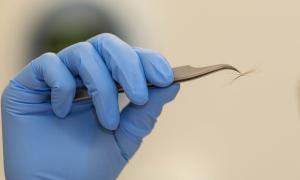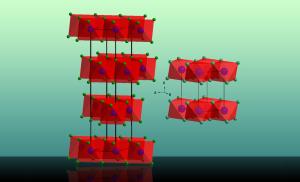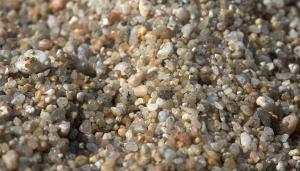LAB REPORT
Science and Technology Making Headlines
Sept. 9, 2016

Glendon Parker, a biochemist with Lawrence Livermore National Laboratory’s Forensic Science Center, examines a 250-year-old archaeological hair sample that has been analyzed for human identification using protein markers from the hair. Photo by Julie Russell/LLNL.
DNA meets its match
Lawrence Livermore scientists say a new method of analyzing genetic mutations in proteins in human hair could lead to the first forensic technique other than DNA profiling that could reliably match biological evidence to a single person with scientific precision.
Using hairs recovered from 76 living people and six sets of skeletal remains from London dating to the 1750s, the team said the technique shows the promise of hair “proteomics,” or the study of proteins that genes produce.
“We are in a very similar place with protein-based identification to where DNA profiling was during the early days of its development,” said Brad Hart, director of the Lab’s Forensic Science Center and co-author of the study with lead researcher Glendon Parker. "This method will be a game-changer for forensics."


Scientists are working to create the conditions at the core of planets such as Neptune.
Peering into other worlds
Scientists have recreated the conditions found deep in the core of giant planets and super-Earths.
They say the work could reveal the material properties that determined planets' formation and evolution processes - and help identify planets likely to hold life.
The team at Lawrence Livermore National Laboratory used laser-driven shock compression and ultrafast diagnostics and were able to measure the melting temperature of silica at 500 GPa (5 million atmospheres), a pressure comparable to the core-mantle boundary pressure for a super-Earth planet (5 Earth masses), Uranus and Neptune.


Ryder Bay near Rothera Research Station, Adelaide Island, Antarctica. LLNL researchers have discovered how methylmercury enters the Antarctic sea ice and accumulates in the marine food web.
Mercury bites into marine life
Researchers from Lawrence Livermore National Laboratory have helped discover how methylmercury enters the Antarctic sea and bioaccumulates in the marine food web.
LLNL scientists Michael Thelen and Adam Zemla performed protein sequence analysis and structural modeling to predict key proteins involved in mercury methylation.
Mercury (Hg) created from volcanoes and human activity such as burning fossil fuels circulates in the atmosphere then deposits onto sea ice. The marine nitrite-oxidizing bacterium Nitrospina, may convert Hg to methylmercury (MeHg), which is released into the Southern Ocean, where it enters the marine food web. Scientists are concerned that MeHg stored in the fatty tissues of fish would contain more mercury than humans can handle and could be a public health concern in the future.


Atmospheric-pressure (left) and high-pressure (right) 2D-layered Lawrencite-type crystal structures of magnesium chloride. Blue and green spheres indicate magnesium cations (positively charged ions) and chlorine anions (negatively charged ions) respectively.
De-ice ice, baby
Raman spectroscopy and X-ray diffraction measurements have worked together with first-principle calculations to examine the high-pressure structural behavior of magnesium chloride at a million atmospheres.
A team of scientists from the Lawrence Livermore National Laboratory and collaborators have investigated the properties of beta-magnesium chloride under pressure, a compound used widely in the aviation industry as a de-icing agent. There also is potential for magnesium compounds under extreme conditions as effective biocidal agents that could be used to neutralize biological weapons.
The high pressure properties of these materials are important for understanding and predicting their behavior in complex, chemically reactive environments such as explosions.


LLNL researchers have measured how force moves through 3D granular materials such as sand and soil. Photo by Sean O’Flaherty.
The force within granular materials
Lawrence Livermore scientists and collaborators have developed a new way to measure how forces move through granular materials.
The method could improve our understanding of everything from how soils bear the weight of buildings to what stresses are at work deep below the surface of the earth.
Granular materials — conglomerations of solid particles larger than a micrometer, such as gravel or coffee grounds — are everywhere. The snow on a mountaintop is a granular material, as is the grain stored in a silo.
Using X-ray diffraction, computed tomography and new mathematical analysis, the team led by LLNL’s Ryan Hurley measured how forces move through a slowly compressed, opaque 3D granular material. The new technique confirmed that forces move spatially through granular materials in patterns that agree with theory and simulations, and tend to behave more uniformly as load is increased.





